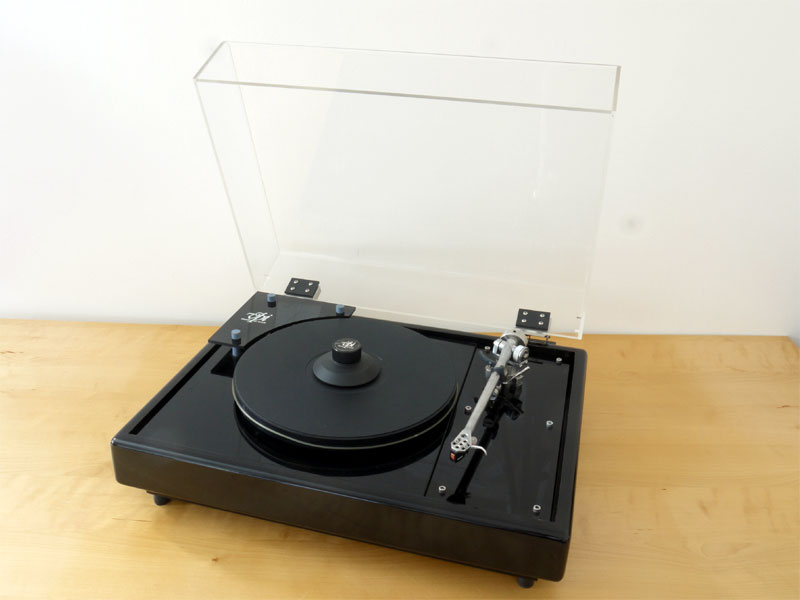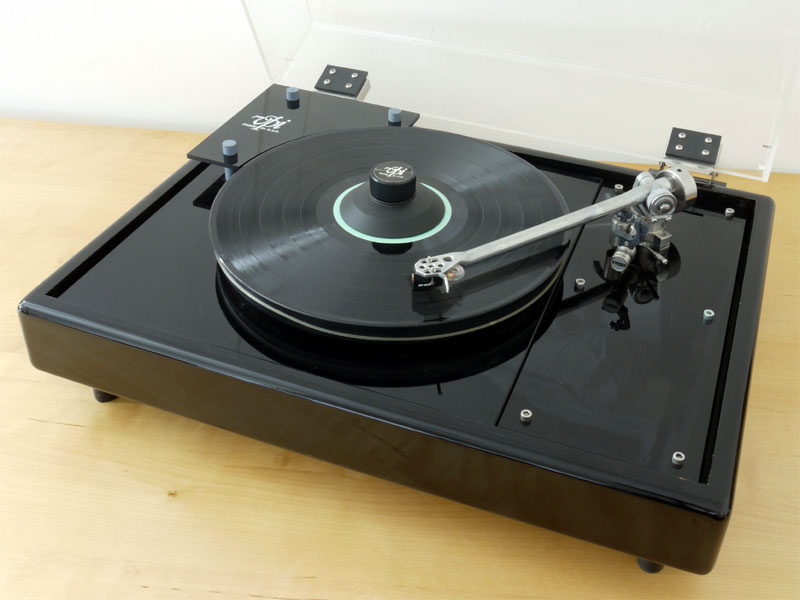What I'd Recommend to a Friend: VPI HW19
 ou only need to look at
the audio news (full of tales of vinyl outselling digital downloads) or the thousands of
images populating those online travelogue show reports (full of turntables from companies
new and old, but all with one thing in common: budget prices) to appreciate that the audio
industry is scrabbling to service a whole new category of customers -- vinyl converts.
Whether they’re new to playing LPs or returning to their roots (whether those roots
are the records that belonged to their parents or their own collection), these customers
likewise all have one thing in common: they need a record player. And suppliers are
queuing up to provide them -- in every size, shape and shade under the sun. I’ve lost
count of the number of people I know who have asked me what record player they should buy
-- often people who’ve owned a fancy turntable at some point in the past. ou only need to look at
the audio news (full of tales of vinyl outselling digital downloads) or the thousands of
images populating those online travelogue show reports (full of turntables from companies
new and old, but all with one thing in common: budget prices) to appreciate that the audio
industry is scrabbling to service a whole new category of customers -- vinyl converts.
Whether they’re new to playing LPs or returning to their roots (whether those roots
are the records that belonged to their parents or their own collection), these customers
likewise all have one thing in common: they need a record player. And suppliers are
queuing up to provide them -- in every size, shape and shade under the sun. I’ve lost
count of the number of people I know who have asked me what record player they should buy
-- often people who’ve owned a fancy turntable at some point in the past.
With all those Pro-Jects, Regas and countless other brands on offer, where on earth do you start? Well, my advice is the secondhand listings, especially if you used to own a decent ‘table in the past. Of course, buying secondhand isn’t without its risks. After all, turntables and tonearms are mechanical devices that are susceptible to mishandling, wear and tear, and such damage isn’t always immediately apparent. They occasionally also demand specialist knowledge or expertise when it comes to setting up or finding hard-to-get spare parts, especially if a company has gone bust or discontinued the model. In fact, buying tonearms secondhand is best left to the experts, so if you are looking for a secondhand record player, it’s best to think in terms of replacing the 'arm with something new; that way, if you don’t have to, it’s a welcome bonus. But amidst all the questionable and exotic options and offerings out there, at least one choice is pretty much bombproof: VPI’s HW19. Harry Weisfeld’s designs were always long on practicality, serviceability and durability, refreshingly free of the sort of arcane BS so many turntable manufacturers seemed to resort to in an effort to differentiate/justify their products. They also sounded inherently engaging and musical -- the very qualities that make vinyl worth bothering with in the first place. The HW19 existed in various guises and sold in droves, making it readily available on the secondhand market, but the pick of the bunch and the most common is the HW19 Mk III. With its rounded, monolithic plinth, it’s much more attractive than the slab-sided construction of the earliest versions, while the mass-loaded acrylic platter with its screw-down clamp delivers decent speed stability and record support/termination. Better still, the main bearing -- the heart of any great turntable -- is apparently all but indestructible, while the suspension system is both effective and simplicity itself. The heavy suspended top plate (laminated stainless steel and acrylic) ensures that not only will the replaceable acrylic armboard accept pretty much any tonearm, including parallel trackers (although not 12" models), levering is as simple as turning the adjustable feet. Need a new or different armboard? All you need is a sheet of 3/8" acrylic and a machine shop.
But best of all, VPI is still very much alive and kicking and able to supply pretty much all of the parts (or alternatives) necessary to keep your new-to-you turntable running, as well as a range of compatible accessories, meaning that this isn’t just a blast from the past but very much an investment in your record-playing future. On top of that there’s also the range of add-ons and upgrades that were available for the ‘table and that still crop up used -- from external power supplies to heavy platters and high-lift lids to accommodate awkward tonearms like the Air Tangent, Eminent Technology and Grado. Good examples of the HW19 Mk III tend to start at around $600, with plentiful tidy options around the $1000 mark. That might seem steep compared to the budget ‘tables being offered these days, but you need to remember that back when it was current, the HW19 was a very serious deck indeed and a genuine high-end contender -- something that actually hasn’t changed. In fact, you might well be shocked at just how good the HW19 Mk III sounds, even these days. The particular example pictured -- quite literally recommended to a friend -- is a very early Mk III, complete with a high-lift lid (and a couple of spare armboards, including one for the Eminent Technology II) and the later optional standalone motor (SAMA). The previously resident Syrinx PU3 tonearm had developed sticky bearings, so while that’s waiting to be refurbished by Audio Origami, its seat has been taken by a Rega RB1000 with a Dynavector DV-20X cartridge. It’s a surprisingly handsome combination, the polished aluminum armtube providing a sharp contrast with the acrylic top plate of the deck. The sound is pretty surprising too, with the clean, crisp, focussed Rega tonearm proving a perfect foil for the expansive warmth of the VPI deck. In fact, in many respects the HW19 Mk III could be said to offer prototypical VPI sound, characterized by the broad, deep soundstage, excellent dimensionality and an almost velvety blackness to the background, no doubt helped by a subtle roll-off at the extreme top end. The high-mass platter and subchassis with its low-frequency springing offer excellent isolation combined with impressive rhythmic articulation and drive. Of course, the other thing contributing to that vast sense of acoustic is the bottom-end weight and extension, both of which are excellent. Piano in particular really benefits from the VPI sound, the instrument reproduced with a weight, scale and presence to rival more than a few of today’s exotic offerings, while vocals are reproduced with just the sort of substance and intimacy that make listeners love vinyl. The range of tonality and musical texture are way ahead of the performance of most starter decks, due in no small part to the laminated platter that avoids the lightness and clipped harmonics of all-acrylic designs. This combination of soundstaging, substance and immediacy is at the heart of what makes this (and later VPIs) so listenable, a quality that some more recent decks have lost in the endless search for detail.
Indeed, so good is the basic HW19 chassis that it’s a fertile basis for upgrades, with an external power supply being the obvious first step (I tried both the Heed Orbit and a PS Audio PowerPlant, different solutions that both offered a worthwhile step up in resolution and dynamic range and a reduction in grain). VPI still holds stock on some of the upgrade options too, so this is a starter turntable that doesn’t only pack an astonishing sonic punch but one that will grow with your system too. Setup is simplicity itself -- just make sure that you have the space to support the 19 1/4" by 13 3/4" footprint. Do take the time and trouble to level the deck precisely; the standing bearing supporting that heavy platter will thank you for your efforts. If you replace the soft rubber feet with hard couplers (standard practice, using Tiptoes back in the day), then make sure that you retain the leveling facility. Otherwise it’s fire it up, sit back and enjoy one of the audio world’s true fit-and-forget masterpieces. In fact, in all of this there is only
one word of caution: You may well also also come across another version of this
‘table, the HW19 Jr, which, as the name suggests, was a lower-priced,
lower-performance model, sharing the same plinth and basic appearance, but substituting
Sorbothane pucks for the suspension; a painted, one-piece MDF top plate instead of the
laminated stainless-steel/acrylic; and a much lighter, all-acrylic platter in place of the
mass-loaded version of the Mk III. It’s still a good ‘table, but don’t
confuse the two: the Jr is a far less capable performer, costs a lot less and should be
far cheaper secondhand. Generally supplied with a Rega or Jelco 'arm, it’s easily
recognized by its matte top plate, (generally) milky-white platter and simple two-part
record clamp. Its inherent upgradeability can also lead to confusion, with parts of the
senior model occasionally appearing on the Jr. Just check what’s actually there and
pitch your offer accordingly. |


